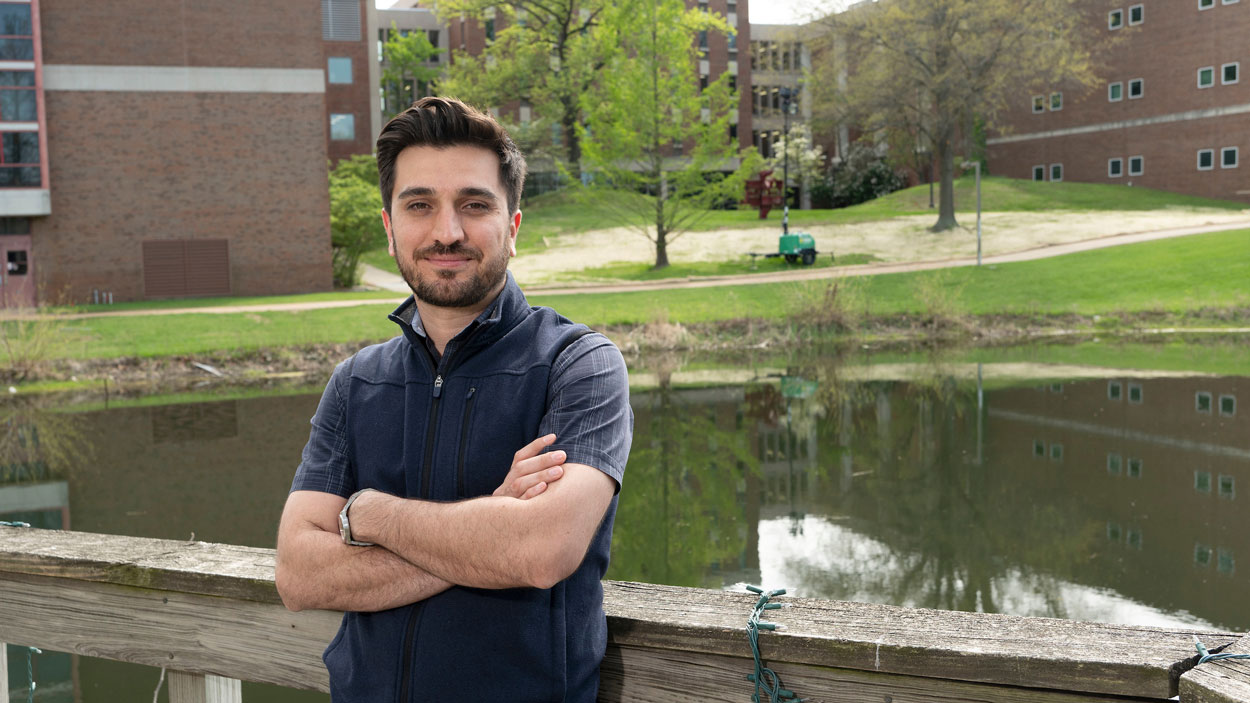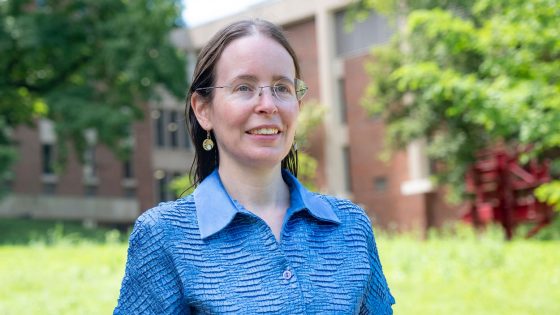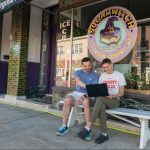
Assistant Teaching Professor Mohi Saki, Professor Erika Gibb and UMSL students are working on research projects with high-profile institutions such as NASA, the Johns Hopkins University Applied Physics Laboratory Jet Propulsion Laboratory and utilizing advanced technology like the James Webb Space Telescope. (Photos by Derik Holtmann)
For thousands of years, humans have looked up at the stars in wonder and contemplated not just what’s beyond our world, but Earth itself.
“I think it all comes down to answering one question, and that question is, ‘How did we come to be?’” says Mohi Saki, an assistant teaching professor of physics and astronomy at the University of Missouri–St. Louis. “I think for every person as a human, they want to know how we ended up on this planet.”
Astrophysicists, such as Saki and colleague Erika Gibb, a professor of physics and astronomy at UMSL, are particularly interested in why there is liquid water on the planet.
“If you look at models of the early solar system, the temperatures where planets like the Earth formed were pretty high,” Gibb says. “One thing that we think you need for life is water, but Earth should not have ended up with water. That’s been a mystery that scientists have been trying to figure out – where did we get our water?”
The far reaches of the solar system and its violent formation may hold the answer. As Jupiter, Saturn, Uranus and Neptune settled into their orbits, they scattered the pieces left behind during planet formation – asteroids and comets – throughout the solar system. The prevailing scientific theory is that some of these celestial bodies – rich in water, in the form of ice, and other organic molecules – impacted Earth.
“That is why we are so interested in studying comets, because they may very well be where Earth got the ingredients that it needed to form life,” Gibb says.
Members of UMSL’s Department of Mathematics, Physics, Astronomy and Statistics have been working diligently to contribute to a greater understanding of these building blocks of the early solar system and, hopefully, life itself. Under the leadership of Gibb, who serves as chair of the department, the university has distinguished itself as a national leader in near-infrared spectroscopy research on comets.
Physics and astronomy faculty members, as well as students, have worked on numerous high-profile research projects with preeminent institutions such as NASA and the Johns Hopkins University Applied Physics Laboratory. These endeavors have garnered National Science Foundation funding and include studies on the composition of comets via the NASA Infrared Telescope Facility at the Mauna Kea Observatory in Hawaii and NASA’s James Webb Space Telescope in orbit around the Sun. The university is also involved in collaborative research such as protoplanetary disk modeling with the Jet Propulsion Laboratory in California.
“We’re very active,” Saki says. “I don’t recall a day that we did not actively participate in this type of research.”
He adds that their work would not be possible without Gibb’s expertise, passion and experience with NASA.
***
Gibb traces her interest in comets to Rensselaer Polytechnic Institute in New York. She was a graduate student at the university when it received a grant from NASA to investigate the origins of life. The interdisciplinary research project sought input from a variety of scientists – biologists, chemists, geologists, physicists and more.
“They would bring in speakers on all these topics, and I was just fascinated by it,” she says. “I wanted to study comets because they are the least processed objects in the solar system. If you want to know where prebiotic molecules were located in the early solar system, comets are the best bet for finding them unprocessed.”

Professor Erika Gibb long-running work with the NASA Infrared Telescope Facility at the Mauna Kea Observatory has brought funding to the university from the likes of the NSF and NASA Missouri Space Grant Consortium. Those projects have also been a vehicle to provide UMSL students with hands-on research experience.
Gibb likens them to fossils, formed and then held in a deep freeze until they get perturbed into an orbit that sends them to the inner part of the solar system. Interested in investigating the subject further, Gibb reached out to Michael Mumma, a NASA astrobiologist renowned for his research on the chemistry of comets. That led to a postdoctoral fellowship with Mumma at the NASA Goddard Space Flight Center, after which she took a position as a visiting research professor at the University of Notre Dame.
As Gibb’s time at Notre Dame was coming to an end, UMSL happened to be looking for someone who could conduct infrared spectroscopy research and lead community engagement initiatives.
“Basically, the job ad read as my resume,” Gibb recalls.
***
Since coming to UMSL in 2005, Gibb has succeeded Bruce Wilking, the former chair of the department whose work centered on interstellar clouds and young star clusters. Now, Gibb and Saki primarily focus on studying the composition of comets using high-resolution near-infrared spectroscopy.
They’re especially interested in observing comet comas, the nebulous atmosphere of gas and dust surrounding the nucleus of comets that makes them “glow” in the night sky. With highly advanced tools such as the James Webb Space Telescope, the researchers can discern the infrared spectrum. This spectrum, which is in the 1-to-30-micron wavelength, is not visible to the human eye, but the telescope can capture it.
During observations, Gibb and Saki are looking for molecular emission lines in the coma. Gibb explains that when a comet enters the inner solar system, the Sun’s radiation starts warming up the comet. In turn, she says, the ice in the nucleus sublimates – goes from a solid to gas without becoming liquid – exciting the molecules present.
“Then we can observe the photons that those excited molecules give off and measure water, hydrogen cyanide, ammonia, methanol, methane, carbon monoxide, ethane, lots of molecules,” Gibb says. “We can do about 10 primary molecules in the near-infrared. These are the very ones that can be used to build more complex molecules that are the precursors for life.”
Theoretically, based on the composition of the coma, they can then extrapolate the composition of the solid nucleus. These observations also serve to create a database of comets and their varying compositions. As each comet is cataloged, they learn more about their assumptions.
“If you want to do science, it’s all about making theories and testing them,” Gibb says. “One of the things we want to understand is the comet population as a whole. Comets individually are very different. We want to make sure we understand whether they are being changed by going around the Sun over and over again. Are we actually measuring what they were originally made of? We want to connect them to not just the early solar system, but to other planetary systems, as well.”
Currently, Saki is leading a project to observe a handful of comets that only come close to Earth approximately every 70 years – a rare opportunity to contribute to this mission.
***
Last March, Saki secured 13.1 hours of observation time on the James Webb Space Telescope to study the composition of six Halley-type comets, those with orbital periods less than 200 years, over the course of about a year. Research time on the telescope is in high demand, and NASA’s acceptance of the proposal speaks to UMSL’s expertise in this area.
Saki is working on the project with Gibb and UMSL alum Nathan Roth (a research assistant professor of physics at American University), as well as colleagues at other institutions including Auburn University, Mohammed VI Polytechnic University in Morocco and NASA’s Goddard Space Flight Center.
The team’s observations began last summer and continued with an observation period from January to February, one from March to May and will conclude with one from May to June. Ultimately, the researchers plan to compare their findings to available data on Jupiter-family comets, those with short orbital periods, which frequently travel through the inner solar system and are thought to suffer the most from thermal processing. They will also compare the findings to available data on Oort-Cloud comets, which have orbital periods of thousands of years.
Saki says near-infrared research has only been published on about 40 comets, roughly 25 being long-period and 15 being short-period, but he hopes to add more to the record. One by one, patterns begin to emerge.
“If you do it enough, you would have a larger collection,” he says. “So, you would have a range or a statistically better value for, let’s say, one of the chemicals versus another one. For example, we know how much volatiles are being released every second in these comets during the time of observations, we can then find the percentage of these with respect to one another. If you do it for over 100 to 200 comets, similar to what has been done in the optical spectrum, then you would have a statistically larger sample size that you can then draw better conclusions about the conditions presented in the early solar system where these comets were formed. So, any new observations are not only meaningful but also with a potential of high impact.”
Thus far, only data on two of the six Halley-type comets from the James Webb Space Telescope project has been processed, but even that is motivating.
“It’s very encouraging, because you see something that you work hard for starting to show the results,” Saki says. “It’s just amazing.”
***
Gibb’s long-running work with the NASA Infrared Telescope Facility at the Mauna Kea Observatory has brought funding to the university from the likes of the NSF and NASA Missouri Space Grant Consortium, but it’s also been instrumental in providing hands-on research opportunities to UMSL students.
Her goal is to get as many students involved as possible. Through these experiences, students learn how to process and analyze data, communicate their findings, adapt when things go wrong and collaborate in the lab.
“They see this problem-solving that you just can’t in a lecture, and it exposes them deeply to the scientific process,” she says.
Jesse Bier, a physics major with an astrophysics concentration, is one such student. Bier is finishing his bachelor’s degree after 20 years in the private sector working in data science and machine learning. He was intent on gaining research experience at UMSL and immediately joined Gibb’s lab as an undergraduate research assistant. Initially, he helped Gibb with recording observation data, but after she learned he had a background and interest in coding and modeling, she connected him with Roth at American University.
Roth, Gibb’s former student, is currently studying the composition of Comet A3, the brightest comet to pass Earth in decades, with the Atacama Large Millimeter Array in the Atacama Desert of Chile. While Gibb and Saki are working in the near-infrared spectrum, which includes primary molecules, Roth is working in the radio spectrum, which includes lower frequency, longer waves that can range from 1 centimeter to 1 kilometer. This portion of the electromagnetic spectrum is different; it contains some primary molecules but also complex molecules such as ethylene glycol. However, the principles of the work are the same.
Bier has learned to code with the CASA toolkit to model blackbody curves, a type of continuous spectrum related to the temperature of an object, and is currently examining the methanol and silicon monoxide levels in A3.
“It’s a dream come true,” he says. “It’s what I wanted to do originally. I didn’t necessarily want to go into data science, machine learning, but I kind of fell into that. I decided now is the time to come back and finish my degree and do what I originally wanted to do. So, it’s a dream come true to be doing astrophysics research.”
***
Gibb and Saki are proud that UMSL is one of the few institutions in the country where this cutting-edge research is conducted. But it may be even more rewarding to know they are contributing to something that’s bigger than themselves or the university by answering the age-old question: How did we come to be?
“The reason for this type of research and the interest of the public goes back to answering that simple question,” Saki says. “I look at it as a big picture. Every single comet that we observe, every discovery, we just add a piece to the puzzle. We’re just at the beginning of it. Eventually, it will be enough that we can go back and look at the bigger picture.”
This story was originally published in the spring 2025 issue of UMSL Magazine. If you have a story idea for UMSL Magazine, email magazine@umsl.edu.














